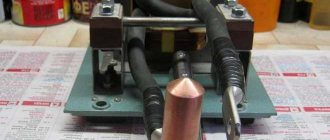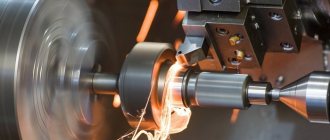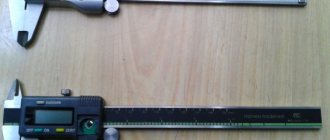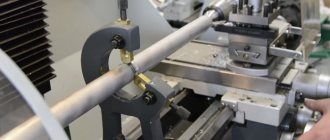We are accustomed to the fact that the voltage in the outlet is always 220 V. Perhaps not all readers suspect that before reaching the consumer, electrical energy conversions were carried out. Before entering the power line wires, the alternating current voltage was increased to tens or even hundreds of kilovolts, and at the output it was lowered to the usual 220 V. These transformations were performed by power transformers. In this article I will tell you what a transformer is in simple words.
The need to convert alternating voltage arises at almost every step. Most often we feel the need to reduce the voltage, since most components of modern electronic devices operate at low voltages. However, some high-voltage circuits require significant voltages, on the order of several thousand volts.
Rice. 1. Industrial transformer
What is a transformer?
In short, this is a stationary device used to convert alternating voltage while maintaining the frequency of the current. The operation of the transformer is based on the properties of electromagnetic induction.
Some historical facts
The operation of the transformer was based on the phenomenon of magnetic induction, discovered by M. Faraday in 1831. The physicist, working with direct electric current, noticed a deflection of the needle of a galvanometer connected to one of two coils wound on the core. Moreover, the galvanometer reacted only at the moments of switching the first coil.
Since the experiments were carried out from a direct current source, Faraday could not explain the discovered phenomenon.
The prototype of the transformer appeared only in 1848. It was invented by the German mechanic G. Ruhmkorff, calling the device an induction coil of a special design. However, Ruhmkorf did not notice the transformation of the output voltages. The date of birth of the first transformer is considered to be the day the patent was issued to P. N. Yablochkov for the invention of a device with an open core. This happened on November 30, 1876.
Types of devices with closed cores appeared in 1884. They were created by the Englishmen John and Edward Hopkinson.
By and large, the technical interest of electromechanics in alternating current arose only thanks to the invention of the transformer. The ideas of the Russian electrical engineer M. O. Dolivo-Dobrovolsky and the world famous Nikola Tesla won the debate about the advantages of alternating voltages precisely because of the possibility of current transformation.
With the victory of the ideas of these great electrical engineers, the need for transformers increased sharply, which led to their improvement and the creation of new types of devices.
General structure and principle of operation
Let's consider the design of a simple transformer with two coils mounted on a closed magnetic circuit (see Fig. 2). The coil that receives current will be called the primary coil, and the output coil will be called the secondary coil.
Figure 2. Transformer design
Virtually all types of transformers use electromagnetic induction to convert the voltage entering the primary winding circuit. In this case, the output voltage is removed from the secondary windings. They differ only in shape, magnetic core materials and methods of winding the coils.
Ferromagnetic cores are used in low-frequency models. The following materials are used for such cores:
- steel;
- permalloy;
- ferrite.
In some high-frequency models, magnetic cores may be absent, and in some products materials made from high-frequency ferrite or alsifer are used.
Due to the fact that the characteristics of ferromagnets are characterized by nonlinear magnetization, the cores are assembled from sheet materials onto which windings are placed. Nonlinear inductance leads to hysteresis, to reduce which the method of lamination of magnetic circuits is used.
The core shape can be W-shaped or toroidal.
Figure 3. Transformer appearance
Basic principles of operation
When a sinusoidal current is supplied to the terminals of the primary windings, it creates an alternating magnetic field in the second coil that penetrates the magnetic circuit. In turn, a change in the magnetic flux provokes the induction of an emf in the coils. In this case, the magnitude of the EMF voltage in the windings is proportional to the number of turns and the frequency of the current. The ratio of the number of turns in the primary winding circuit to the number of turns of the secondary coil is called the transformation ratio: k = W1 / W2 , where the symbols W1 and W2 indicate the number of turns in the coils.
If k > 1 , then the transformer is step-up, and if 0 < k < 1, then the transformer is step-down. For example, when the number of turns that make up the primary winding is three times less than the number of secondary turns, then k = 1/3 , then U2 = 1/3 U1 .
Operating modes
The power transformer can operate in three modes:
- in idle state;
- in load mode;
- in short-circuited mode.
Since there is no current in the open circuit of the secondary winding, in this state no-load current circulates through the primary winding. The parameters of this current are used in efficiency calculations, the transformation ratio is determined, and losses in the core are found.
The main operating mode of the transformer is the state when the rated load is connected to its second winding. The primary current can be expressed through the resultant no-load current and the calculated load resistance current.
In short circuit mode of the secondary winding, all power is concentrated in the winding circuits. In this state, it is possible to determine the losses spent on heating the wires in the windings.
Sequence of action and characteristics
Regardless of the design type, direct current is supplied to the primary winding. In this case, to power the field effect transistor, it is necessary to create a square wave with an amplitude from 0 V to + 12 V, and the transformer will need a primary waveform, which has an average value close to zero.
The magnetic flux in the core is not reset, so somewhere along the line there is saturation. As a result, the residual flux left over from one switching cycle is created by the next cycle: the high-frequency transformer is said to “go into saturation”.
The current and voltage parameters on the primary winding of the transformer are changed using a unipolar source follower, and the operating range reaches 12 V. At low loads, the same oscillations are also reproduced by the secondary winding. However, there are also differences. Current in the primary winding flows in only one direction. At high voltage it increases at one rate, and at low voltage at another.
Important! When the output signal goes low, the current is cut off much faster, distorting its waveform. Therefore, the transformer is controlled using a bipolar signal, when the current flows symmetrically in both directions.
Device operating parameters include:
- Pulse: Ensures that the inductance remains within the specified range and avoids saturation.
- Switching mode functionality that contains three chokes and a switching transformer.
- The feedback method is based on the output voltage, which is a function of current retention in the transformer (the reverse version, with current control, is less common).
- The operating voltage on the inverter is from 1000 V, at low input voltage.
- Type of insulation. Calculated for a total voltage in the range of 15 ... 200 V.
Main applications: renewable energy installations, hybrid vehicles, industrial drives, as well as devices designed to control energy distribution.
Specifications
An important characteristic is transformation ratios. They show the dependence of the output voltage on the ratio of turns in the windings. The transformation coefficient is the basic parameter in the calculation.
Another important characteristic of a transformer is its efficiency. In some devices this figure is 0.9 – 0.98, which characterizes insignificant losses of magnetic stray fields. Power P depends on the cross-sectional area S of the magnetic circuit. Based on the value of S, when calculating the parameters of the transformer, the number of turns in the coils is determined: W = 50 / S.
In practice, power is selected based on the expected load, taking into account losses in the core. The power of the secondary winding is Pн = Un× Iн , and the power of the primary coil is Pс = Uс × Iс . Ideally, Pn = Pc (if we neglect losses in the core). Then k = Uс / Un = Iс / Iн , that is, the currents in each of the windings have an inversely proportional dependence on their voltages, and therefore on the number of turns.
Features of design and use
The positions by which the devices in question are selected are:
- Consumed input voltage, V – 0….15000.
- Output voltage, V – 0….6000.
- Reactive power, kVA – 0.25….5000 (for reputable manufacturers, this characteristic does not depend on the duration of the unit).
- Load power factor – 0…100% (lag or lead).
- Frequency, Hz – 20…100000.
- The network phase is single- or three-phase.
- Electrostatic shielding is mandatory and may include one or more protective shields.
- Housing design - for operation in normal or aggressive environments.
An important selection parameter is the material of the cores. Two types of construction are used. In the shell type, the windings are located on a common leg of the core, and in a core-type transformer, the windings are wound on different branches of the transformer. Due to the fact that the main objective of the effective use of a high-frequency transformer is to ensure maximum flux coupling, the thickness of the wire is selected taking into account the operating current that will power the device. Tertiary windings of high-frequency transformers are less common.
The main materials used for the manufacture of cores are determined by the purpose of the device. For example, power transformers operating at line frequency may have soft iron cores to magnetically connect the primary and secondary windings.
Important! For high-frequency transformers, soft iron is unsatisfactory because the material has too much "memory" - that is, inertia enough to reverse the magnetic field when the current in the primary winding is reversed.
For audio transformers, iron is predominantly used, modified with silicon or nickel elements, which reduce the memory effect. The designs of radio frequency transformers use compacted powder materials – ferrites.
Winding methods are also different. High-frequency converters in audio technology need a quick response to changes in the magnetic field, so during their production the primary and secondary windings are placed on top of a certain location on the core.
Radio frequency transformers require the greatest efficiency in control, so they are often wound bifilarly, when the primary and secondary wires are simultaneously wound around the core. This method minimizes losses and provides direct magnetic coupling between the windings.
Types of transformers
In order to solve the problems of voltage transformation in various circuits, transformers of various designs have been invented. Manufacturers choose their own magnetic core concepts (see Fig. 4), which do not affect the operation and parameters of devices:
- rod type (mainly used for three-phase structures);
- armor type (three-phase devices);
- The toroidal core type is often used in transformers used in various electrical devices.
Types of magnetic circuits
A wider range is covered by classification by purpose.
Power
The purpose of a power transformer is clear from the name. The term power is applied to a family of models, usually of high power, used to convert electrical energy in power transmission lines and in various service installations.
During transformation, alternating current frequencies are maintained, so it is possible to connect power transformers in groups for operation in high-voltage three-phase networks.
Power devices can be connected in groups with different winding connection patterns: asterisk, triangle or zigzag. The star circuit is justified if the load in three-phase networks is symmetrical. Otherwise, preference is given to the triangle. With this connection method, the currents of the primary winding separately magnetize each core magnetic circuit.
Then the single-phase resistance will approach the calculated one, and the voltage imbalance will be eliminated.
Autotransformers
A group of devices in which the primary and secondary windings form an electrical connection due to their direct connection to each other are called autotransformers. A characteristic feature of this group is several pairs of terminals to which a load can be connected.
The windings of autotransformers have not only magnetic but also electrical connections. They have found application in connections of grounded networks operating at voltages exceeding 110 kV, but at low transformation ratios - no more than 3 - 4.
Current
You can connect the primary winding in series in an electrical circuit with other devices and obtain galvanic isolation. Such devices are called current transformers. The primary circuit of such devices is controlled by changing the single-phase load, and the secondary coil is used in measuring instrument or alarm circuits. The second name for the devices is instrument transformers.
A special feature of the operation of instrument transformers is the special mode of the output winding. It operates in critical short circuit mode. When the secondary circuit breaks, a sharp increase in voltage occurs in it, which can cause breakdowns or damage to the insulation.
Current transformer
Voltages
A typical application is to isolate high-voltage protection logic circuits for measuring instruments. A voltage transformer is a step-down device that converts high voltage to lower voltage.
Pulse
Modern electronics use high-frequency signals, which often need to be separated from other signals. The task of pulse transformers is to convert pulse signals while maintaining the pulse shape.
For high-frequency pulse devices, requirements are put forward for maximum preservation of the output pulse shape. It is the shape that matters, not the amplitude or even the sign.
Welding
A high welding current is important in the operation of a welding machine. At the same time, the mains voltage is reduced to a safe level. Thanks to the powerful electric current, the arc discharge of the welding machine melts the metal.
The welding transformer has the ability to stepwise regulate the current value in the secondary circuits by changing the inductive reactance, or by sectioning one of the windings.
A photo of the device is shown in Figure 6. Note the presence of a commutation switch.
Rice. 6. Transformer for a semi-automatic welding machine on an armored magnetic circuit
Welding machines use designs based on single-phase transformers, as well as using three-phase transformers. To weld some metals, such as stainless steel, the welding current is rectified.
Separating
Devices in which there is no electrical connection between the windings are called sharing transformers. Power separating devices are used to improve the safety of electrical networks. Another area of application for isolation transformers is to provide galvanic isolation between individual components of electrical circuits.
Coordinating
These types of devices are used to match the resistance of cascades of electronic circuits. They provide minimal distortion of signal shapes and create galvanic isolation between components of electronic devices.
Peak transformers
Devices that convert sinusoidal currents into pulse voltages. The polarity of the output voltages changes every half cycle.
Air and oil
Power transformers are dry (air-cooled) (see Fig. 7) and oil-oil (see Fig. 8).
Models of dry power transformers are most often used to convert network voltages, including in three-phase network circuits.
Figure 7. Dry three-phase transformer
When a load is connected, the windings heat up, which threatens to destroy the electrical insulation. Therefore, oil-cooled devices operate in networks with voltages above 6 kV. Special transformer oil increases insulation reliability, which is very important at high output powers.
Rice. 8. Structure of an oil-cooled industrial transformer
Twin throttle
Structurally, such a device is a transformer with identical coils. Coils of equal power form a counter inductive filter. The efficiency of the device is higher than that of a throttle (with the same dimensions).
Rotating
Used to exchange signals with rotating reels. Structurally, they consist of two halves of a magnetic circuit with coils. These parts rotate relative to each other. Signal exchange occurs at high rotation speeds.
Main parts and systems of power transformer
The metal casing is designed to house the electrical equipment of the transformer inside it. It is a sealed tank with a lid filled with transformer oil. This type of oil has high dielectric properties; it helps remove heat from parts subject to significant current loads.
The transformer is cooled using a hydraulic system.
Filling and draining of oil is done using valves and screw-in plugs. Oil is sampled for chemical analysis through a shut-off valve located at the bottom of the tank. Oil circulation in a power transformer occurs through two circuits - external and internal. The external circuit includes a radiator consisting of upper and lower collectors connected to each other by metal tubes. The heated oil passes through the cooler lines, cools down and re-enters the tank. Inside the tank, oil can circulate naturally or forcibly under the influence of pressure created by pumps. Heat transfer is significantly improved due to special corrugations installed on the surface of the tank.
The most important element of a power transformer is its electrical circuit . All its elements are located inside the housing. The upper and lower beams make up the frame on which all other parts are attached. The circuit includes a magnetic core, high- and low-voltage windings, high-voltage and low-voltage taps, and control branches of the windings. At the bottom there are high and low voltage inputs.









